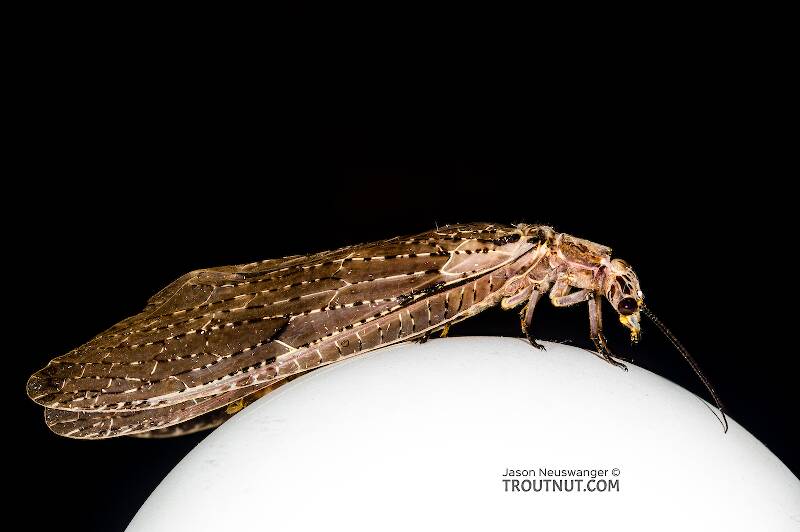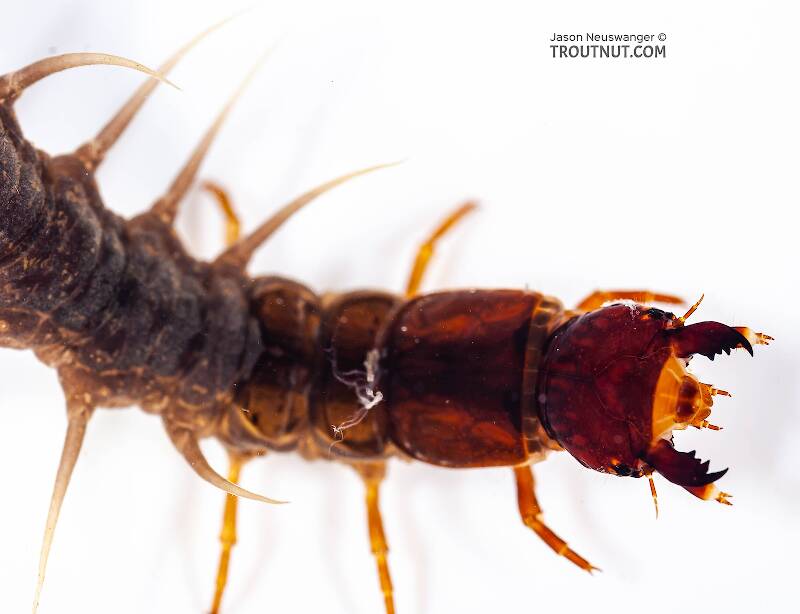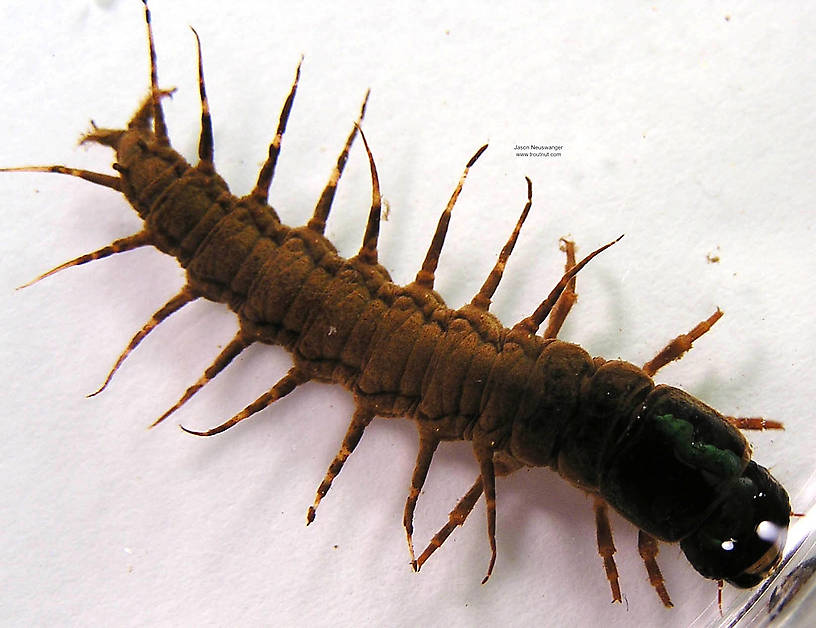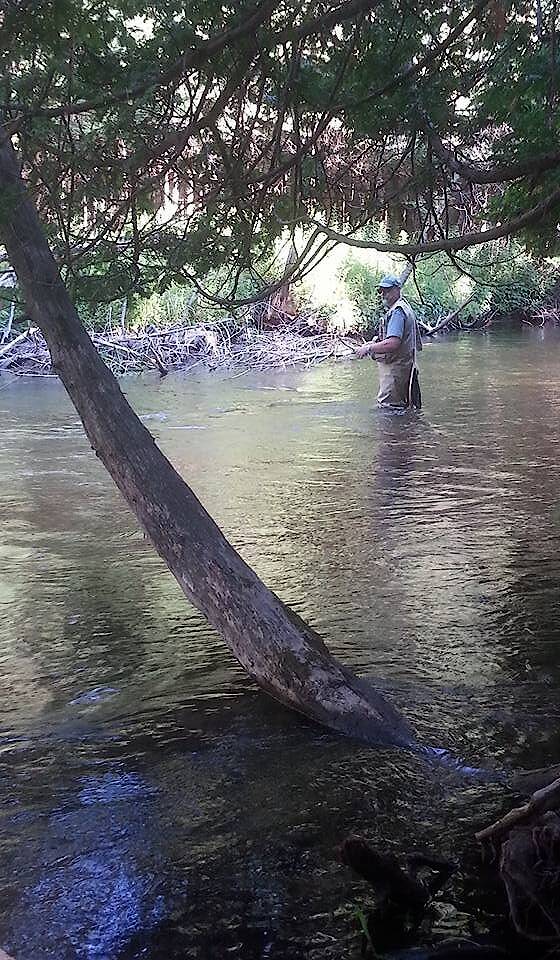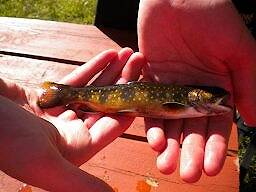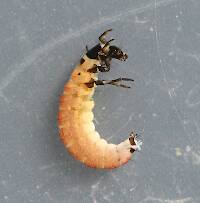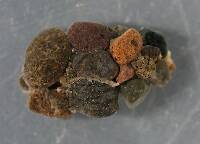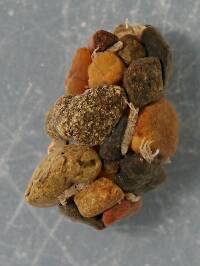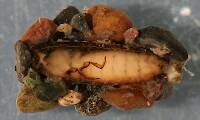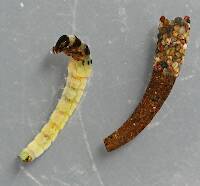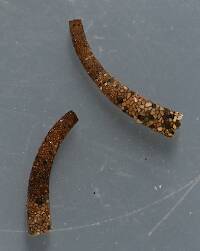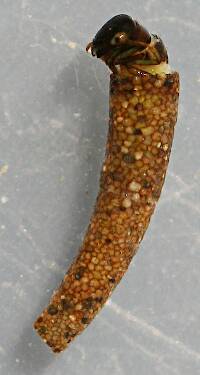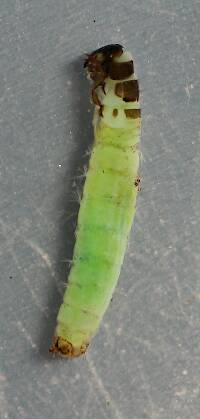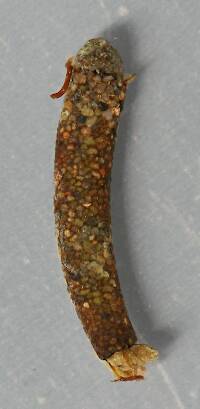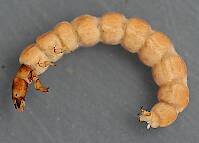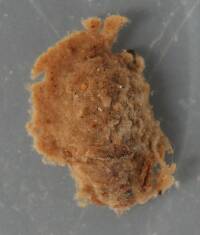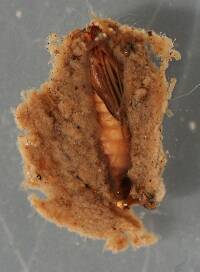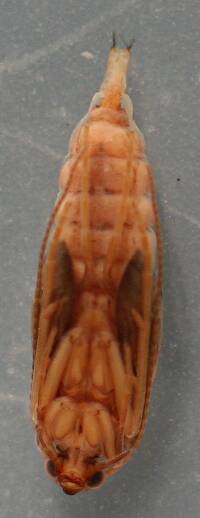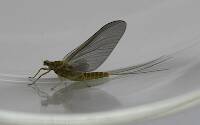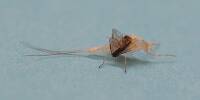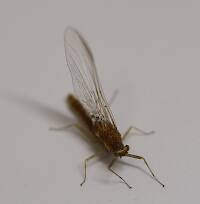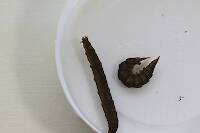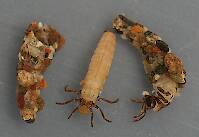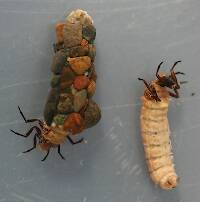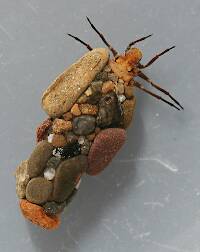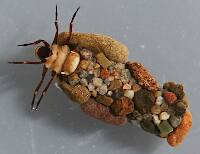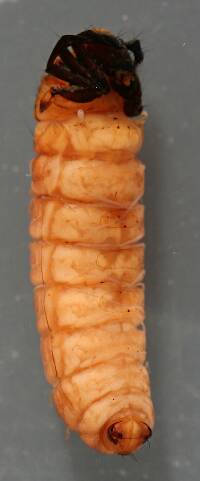
Hex Mayflies
Hexagenia limbata
The famous nocturnal Hex hatch of the Midwest (and a few other lucky locations) stirs to the surface mythically large brown trout that only touch streamers for the rest of the year.
Featured on the forum

This one pretty clearly keys to Kogotus, but it also looks fairly different from specimens I caught in the same creek about a month later in the year. With only one species of the genus known in Washington, I'm not sure about the answer to this ID.

Troutnut is a project started in 2003 by salmonid ecologist Jason "Troutnut" Neuswanger to help anglers and
fly tyers unabashedly embrace the entomological side of the sport. Learn more about Troutnut or
support the project for an enhanced experience here.
This topic is about the Insect Family Corydalidae
Hellgrammites are the vicious larvae of the Dobsonflies, some of the only trout stream insects which pose a biting threat to the angler. The pincers of the adult are even more frightening that the larva's, and they're aggressive enough to use them once in a while.This family's life cycle does not create good dry fly opportunities, but the larvae may be eaten by trout year-round. They are a secret told only by stomach samples of well-fed trout.
Example specimens
Zach19
Posts: 1
Posts: 1
Zach19 on Jul 13, 2007July 13th, 2007, 7:44 am EDT
Anybody know how these hellgrammites can live underwater so long then when me and my dad catch them for bait...can keep them for up to a week or so and still be alive? Am i the only one who finds that odd? Also, these are absolutely by far the best smallmouth bass bait i have ever used. My dad just recently caught a 4.5 lb. bass on one, and we live in Wisconsin. Though they can be a pain in the you know what to catch...me, my brother and my dad can catch up to 50 or so each time we go out, which is about maybe 5 times a year if that. We have an excellent place to go under a bridge where there are a lot of rocks, prime place to catch hellgrammites. These things look so pre-historic, and it still wows me how much those pinchers can hurt. Is it true that these are also great for trout? Any information from anybody who has used these hellgrammites for any other kind of fish i would really appreciate.
ReeBoldt on Sep 20, 2011September 20th, 2011, 11:18 am EDT
Hey everyone they are not only good for Trout but Catfish love them too. My family and I used to go to the Colorado River twice a year. We would have about three trot lines ran across the river and would put these on them; they loved them.
Oldredbarn on Sep 20, 2011September 20th, 2011, 12:03 pm EDT
Murray’s Hellgrammite
Tyer: Dave Kollmann
St. Cloud Fly Anglers
Hook: Mustad 9672 #6 - #4, or 9674 #6
Thread: Black 6/0 (140 denier)
Weight: 8 wraps of .030 lead wire on front 1/3 of hook shank.
Tail: Black Ostrich plume 18-24 strands, 1 1/4 X length of hook shank.
Rib: #16 ga. copper wire counter wrapped through hackle.
Body: . Black chenille Med.
Hackle: Black strung neck hackle palmered, long and webby.
Antennae: Black, round rubber leg, Med.
Fishing Methods:
Dead drift the hellgrammite year around. This is basically glorified woolly Bugger. Just an all around great pattern to try any time of year.
"Even when my best efforts fail it's a satisfying challenge, and that, after all, is the essence of fly fishing." -Chauncy Lively
"Envy not the man who lives beside the river, but the man the river flows through." Joseph T Heywood
"Envy not the man who lives beside the river, but the man the river flows through." Joseph T Heywood
Taxon on Sep 20, 2011September 20th, 2011, 2:57 pm EDT
Hi Zach-
I would guess that it has to do with dobsonflies having a non-aquatic pupal lifestage, which would seemingly require them to development a prepupal atmospheric oxygen respiration strategy.
Anybody know how these hellgrammites can live underwater so long then when me and my dad catch them for bait...can keep them for up to a week or so and still be alive?
I would guess that it has to do with dobsonflies having a non-aquatic pupal lifestage, which would seemingly require them to development a prepupal atmospheric oxygen respiration strategy.
Oldredbarn on Sep 21, 2011September 21st, 2011, 5:51 am EDT
which would seemingly require them to development a prepupal atmospheric oxygen respiration strategy.
Roger,
You did...n't...:) I want you to know I'm restraining myself big time here mister...Behaving myself this morning and all. Maybe Gonzo should take this one...I've caused enough trouble here lately...
I just think that they too ugly and mean to die...How about them apples?
Spence
"Even when my best efforts fail it's a satisfying challenge, and that, after all, is the essence of fly fishing." -Chauncy Lively
"Envy not the man who lives beside the river, but the man the river flows through." Joseph T Heywood
"Envy not the man who lives beside the river, but the man the river flows through." Joseph T Heywood
Taxon on Sep 21, 2011September 21st, 2011, 7:21 am EDT
Hi Spence,
Unless you are referring to my erroneous use if "development" rather than "develop" in the above quoted clause, I'm not sure exactly what is causing you to have to restrain yourself. Please explain.
Unless you are referring to my erroneous use if "development" rather than "develop" in the above quoted clause, I'm not sure exactly what is causing you to have to restrain yourself. Please explain.
Oldredbarn on Sep 21, 2011September 21st, 2011, 7:53 am EDT
No...Roger...That's not it...Let's just move on here, Ok? There's nothing to see except an infantile youngster in the back row turning everything he hears in to a fart joke or some-such...Sorry!
It's something at 57 I need to work through...:)
Spence
It's something at 57 I need to work through...:)
Spence
"Even when my best efforts fail it's a satisfying challenge, and that, after all, is the essence of fly fishing." -Chauncy Lively
"Envy not the man who lives beside the river, but the man the river flows through." Joseph T Heywood
"Envy not the man who lives beside the river, but the man the river flows through." Joseph T Heywood
Wbranch on Sep 22, 2011September 22nd, 2011, 4:48 pm EDT
Roger,
A kid obviously posted the initial inquiry therefore your scientific response probably meant absolutely nothing to him - it meant little to me too - very few of us Forum members are so astutely informed relative to the intricacies of the river insects we try to replicate with our flies.
A kid obviously posted the initial inquiry therefore your scientific response probably meant absolutely nothing to him - it meant little to me too - very few of us Forum members are so astutely informed relative to the intricacies of the river insects we try to replicate with our flies.
Catskill fly fisher for fifty-five years.
Taxon on Sep 22, 2011September 22nd, 2011, 6:55 pm EDT
Hi Matt-
Would it have been better if I had simply responded, the hellgrammites you collected with your father apparently had the ability "breathe" while out of the water.
your scientific response probably meant absolutely nothing to him - it meant little to me too
Would it have been better if I had simply responded, the hellgrammites you collected with your father apparently had the ability "breathe" while out of the water.
Jmd123 on Sep 23, 2011September 23rd, 2011, 6:57 am EDT
Seems to me that a good hellgrammite imitation would be to simply take an all-black Woolly Bugger, chop off most of the marabou tail (leaving maybe 1/4"), and trim the hackle to a length of 1-2 mm. Doncha think?
Jonathon
Jonathon
No matter how big the one you just caught is, there's always a bigger one out there somewhere...
Wbranch on Sep 23, 2011September 23rd, 2011, 6:30 pm EDT
Hi Roger,
You wrote - "Would it have been better if I had simply responded, the hellgrammites you collected with your father apparently had the ability "breathe" while out of the water."
Yes!, a perfect explanation for the novice bug collector. Now even I understand!
You wrote - "Would it have been better if I had simply responded, the hellgrammites you collected with your father apparently had the ability "breathe" while out of the water."
Yes!, a perfect explanation for the novice bug collector. Now even I understand!
Catskill fly fisher for fifty-five years.
Dm3t on Jan 5, 2012January 5th, 2012, 4:57 am EST
As a kid we used to lay a net behind a rock, lift the rock and grab the hellgramites quickly before they pinch you! Ive been pinched several times some times, it did smart! we'd catch them in the net. the water was less than 12" deep and fast moving. We caught tons of smallmouths with them! I'd like to use a fly for brown trout on Oatka creek if I find a good pattern. I heard big trout like them them even in winter. I'd like to read your article on them.
Don Masten
Don Masten
PaulRoberts on Jan 5, 2012January 5th, 2012, 7:40 am EST
I wrote an article on the Megaloptera (hellgrammites) in the Jul/Aug 99 issue of American Angler. Only have one copy left though.
The particular fly I introduced in that article, the UltHellgrammite, is essentially a ramped up Woolly Bugger. It accounted for more of my, and friends, largest resident small-stream browns than any other fly. My best was a 23" behemoth, and my buddy took a 22 from another smallish creek. I also used a Sialid (smaller Megalopterid also with 2-yr life cycle) mimic in winter, after pumping some from trout stromachs in the dead of winter. Both trout, and Sialid larvae inhabit pools/depositional areas in winter.
The hook I used, which in the article said was "hard to find" is only hard to find if you are not a bait fisher lol. It's the Mustad 37140 –a “Kahle”-bend baithook. Great hook with excellent holding power and strength for its wire diameter.
I think I posted something on this fly before. Will look.
Here ‘tis:
http://www.troutnut.com/topic/3237/Dobson-Fly
Oh...if you are not a tier, a regular old Woolly Bugger in black or dark brown, or better, a muddy gray -each with a large black head (permanent marker will do the trick) will work very well.
The particular fly I introduced in that article, the UltHellgrammite, is essentially a ramped up Woolly Bugger. It accounted for more of my, and friends, largest resident small-stream browns than any other fly. My best was a 23" behemoth, and my buddy took a 22 from another smallish creek. I also used a Sialid (smaller Megalopterid also with 2-yr life cycle) mimic in winter, after pumping some from trout stromachs in the dead of winter. Both trout, and Sialid larvae inhabit pools/depositional areas in winter.
The hook I used, which in the article said was "hard to find" is only hard to find if you are not a bait fisher lol. It's the Mustad 37140 –a “Kahle”-bend baithook. Great hook with excellent holding power and strength for its wire diameter.
I think I posted something on this fly before. Will look.
Here ‘tis:
http://www.troutnut.com/topic/3237/Dobson-Fly
Oh...if you are not a tier, a regular old Woolly Bugger in black or dark brown, or better, a muddy gray -each with a large black head (permanent marker will do the trick) will work very well.
Pylgrym on Aug 19, 2013August 19th, 2013, 1:33 pm EDT
INSTARS! These Megaloptera may have as many as seven stages of growth before exiting their streambeds; that could mean a lifespan of up to seven YEARS ...? Couple this with Complete Metamorphosis ... mystery bugs ...
"Ye Must Be Born Again"
Taxon on Aug 19, 2013August 19th, 2013, 2:21 pm EDT
Pylgrym-
The larval growth (toward maturity) of aquatic insects is continual, but is restricted by the relative inflexibility of their external skeleton. So, that exoskeleton is periodically shed in order to accommodate additional larval growth. This happens (10 to 12) times in the case of corydalid larvae, whose larval lifestage duration can vary from (2 to 5) years.
The larval growth (toward maturity) of aquatic insects is continual, but is restricted by the relative inflexibility of their external skeleton. So, that exoskeleton is periodically shed in order to accommodate additional larval growth. This happens (10 to 12) times in the case of corydalid larvae, whose larval lifestage duration can vary from (2 to 5) years.
Roguerat on Aug 19, 2013August 19th, 2013, 4:40 pm EDT
I've had success with Murray's Hellgrammite pattern, sort of a Wooly-Bugger-based fly with an Ostrich herl tail. I use light brown Ostrich for the tail, since the bugs in my neighborhood tend to be more brownish than black.
Roguerat
I Peter 5:7 'Cast your cares upon Him...'
Roguerat
I Peter 5:7 'Cast your cares upon Him...'
Trout_House on Aug 23, 2013August 23rd, 2013, 8:21 am EDT
I put a hellgrammite in my aquarium, and it killed some large golden stones. Hardy little suckers
Quick Reply
Related Discussions
Topic
Replies
Last Reply
1
Mar 10, 2007
by Troutnut
by Troutnut
5
Jun 28, 2011
by PaulRoberts
by PaulRoberts
4
Oct 29, 2014
by Millcreek
by Millcreek
4
Apr 12, 2014
by Brookyman
by Brookyman


